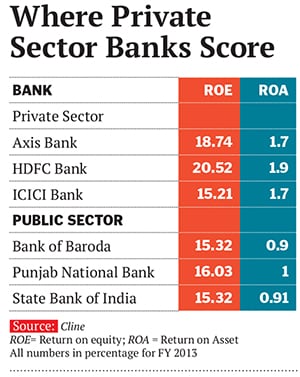A Licence to Print Money in Underbanked India
While banking is an oligopoly in the private sector, the public sector is huge, but inefficient. Little wonder there is a rush for new licences in a country as underbanked as India


If the Ministry of Finance has its way, and if the Reserve Bank of India does not drag its feet, some time next year, you would be able to choose from a wider range of banks. Will this change anything for customers? Will the new banks succeed? The short answer to these two questions is No and Yes. Here’s why.
Banking seems like a tough business from the outside, a mix of expensive technology and complex processes, all designed to guard against a huge risk: Having to lend a lot of money for a small profit, money that is borrowed and many times the size of the bank’s capital. If a Kingfisher crashes, banks lose money if the payment of an outstanding on a credit card does not come, they lose money if the home loan borrower defaults, they lose money. And this money is not theirs—it belongs to the depositors. So managing lending risks is paramount if banks have to succeed.
But banks have four natural strengths that any business would die to acquire: One, large and ever-growing demand two, sticky customers three, high entry barriers and four, lack of real competition. There are not many large businesses in India which can claim these strengths, except to some extent cable TV and mobile phone services.
Growing Demand: India is hugely underbanked, and from consumers to businessmen, people need to borrow. As more and more people climb up the prosperity ladder, the need to borrow and the size of the borrowing are both increasing. Banks, like consumer products and pharmaceutical companies, are pretty much enjoying a period of secular growth. That growth gets combined with the second factor.
Stickiness: Once you are a customer of a particular bank, you are reluctant to change. Sometimes you have no option but to stay put. Your salary account could be tied to a particular bank. Or the bank branch is next door and, therefore, it’s your best choice. Pensioners cannot change their bank accounts easily. Try to close your bank account and see how it is met with highly persuasive salesmanship, even from public sector banks. Businessmen who have cash credit and term loans are even more tied to their banks. Stickiness of customers is one reason why banks have a good thing going.
High Entry Barrier: But banks have a third strength that even cable TV and telecom businesses don’t have: Well-guarded entry barriers put up by a supportive regulator. The first time the RBI allowed the entry of new banks was in 1993, when nine ‘new’ private banks were allowed to set up shop. In 2001, it allowed Kotak Mahindra to convert into a bank and gave a green signal to Yes Bank. A co-operative, Development Credit Bank, was also allowed to convert into a regular private bank. That’s all. So, in two decades of rapid increase in prosperity across the country, just 11 new banks have come up. But, of the 11 new banks only one (Global Trust Bank) actually failed. And even this failure did not result in massive losses. It got absorbed in the ‘system’ overnight. And the rest? They are thriving.
Low Competition: A business that enjoys these three merits also enjoys a fourth one: Lack of effective competition that could have depressed profits. There may be many banks in India and bank branches may be present in every nook and corner but, for the three reasons outlined above, banks don’t quite compete with one another. Indeed, there is enough anecdotal evidence that banks are colluding with one another often enough to extract more from their customers, sometimes at the risk of losing the trust and faith of customers completely.
More than a decade ago, the RBI allowed banking charges to be market-driven. It also allowed banks to sell third party products like mutual funds, insurance, private equity and portfolio management services. These two factors have yielded windfall profits for banks at the expense of customers. Just a few weeks ago one private bank announced that it would charge for the SMS alerts of transactions. Other private banks quickly followed suit, and then some public sector banks too levied a charge. This is a pattern now. Often the most aggressive and profitable private sector bank will announce an increased charge and the rest will follow.
Competition? Forget it. In fact, in one case reported by Moneylife, a senior finance ministry official even sent a directive to a public sector bank to follow that private sector bank’s decision to increase charges.That apart, customers don’t know that banks often shortchange them on interest or follow different strategies for deducting taxes, which affects the rate at which fixed deposits are compounded. Then there are charges on bounced cheques (paid not by the erring drawer, but the hapless drawee!), or cash deposited in non-home branches and so on. These are small charges picked up from millions of customers and shared by just a few banks, adding crores to their bottomline. A clear example of oligopoly in action.
An even bigger menace is the widespread losses depositors have suffered when sweet-talking relationship managers hustle them into third-party products for fat commissions. The mass retail is targeted with insurance products while the high net worth customers are herded into portfolio management services, structured products and private equity funds or even simple mutual funds churned many times over. What helps is that the banker alone knows exactly how much money you have at any time in your account.
Small businessmen have a different problem. To get a loan they sometimes have to buy these third party products and help the branch meet a quarterly profit or deposit targets. Can customers walk away to another bank? If bankers, banking regulators, sundry policy makers and academics would have you believe that businessmen can indeed do that, they have no clue about the ground realities.
So, to recap, the reason for the spectacular success of private banks is that entry and, therefore, competition is regulated, demand is growing, customers are by and large locked in and are handing over higher revenues to these banks because of the lack of effective alternatives. It is a good business to be in. What also helps is that public sector banks, hobbled by politically-influenced boards, poor lending practices and deep-rooted inefficiency, not only do not offer any competition, but sometimes set up a high-cost base for private sector banks to ride on.
Every new bank that was serious about its business and had a decent management in place has succeeded wildly. This is best reflected in the share prices of some of these banks. Kotak Mahindra Bank’s stock was Rs 4 in 2001 (split and bonus-adjusted). It is over Rs 750 now, up almost 18,650 in 12 years. Axis Bank was listed at around Rs 17 in December 1998. It is now almost Rs 1,300, a rise of over 7,500 percent. Both have done far better than the 1,500 percent rise in Bharti Airtel’s shares from March 2002. These numbers are only illustrative. But there is no denying that the main driver for this incredible value creation has been super profits, and expectations of continued profit growth, thanks to their lock on customers and against competitors. In the past five years, the net profit of Axis Bank has soared three times and nobody feels its business model is under stress.
The new banks that the RBI may license over the next few months will do well over the long term, provided they are run by the kind of efficient private sector bankers who have delivered great value to their employers and shareholders. This does not mean that banking is by any means easy. It is highly capital-intensive and takes years to build. It also requires a top-notch management team to execute according to plan. After all, there is nothing exciting for customers in banking. Premium banking services have to be pushed all at the same time. But it does not hurt that banking is a protected business that can extract money from its customers in every which way.
The writer is the founder, editor and publisher of www.moneylife.in and has almost 30 years of experience in business analysis and writing
First Published: Aug 06, 2013, 06:28
Subscribe Now